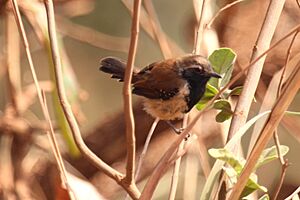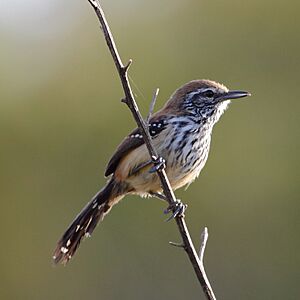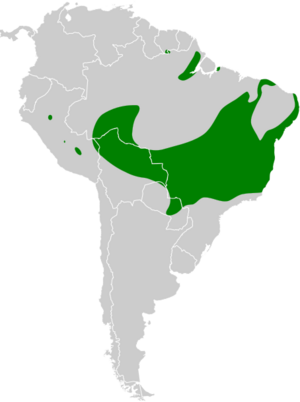Rusty-backed antwren facts for kids
Quick facts for kids Rusty-backed antwren |
|
|---|---|
 |
|
| Male in Mato Grosso | |
 |
|
| Female at Dourado, São Paulo state, Brazil | |
| Conservation status | |
| Scientific classification | |
| Genus: |
Formicivora
|
| Species: |
rufa
|
 |
|
The rusty-backed antwren (Formicivora rufa) is a small bird that belongs to a group of birds called "typical antbirds." You can find this bird in several South American countries, including Bolivia, Brazil, Paraguay, Peru, and Suriname.
Contents
About the Rusty-backed Antwren
The rusty-backed antwren is a small bird, usually about 12 to 13 centimeters (around 5 inches) long. It weighs about 11.5 to 14 grams, which is about as much as a few paperclips!
What Do They Look Like?
Male rusty-backed antwrens have a reddish-brown top of the head and back. They have a white stripe above their eyes, and their face and throat are black. The middle of their chest is also black, with a white edge. Their sides are a cinnamon-buff color, and their belly is white. When their wings are folded, you can see lines of white dots. Their tail feathers are black with reddish-brown edges and white tips.
Female rusty-backed antwrens look a bit different. Their reddish-brown upper parts are usually lighter than the males'. Their face, throat, and chest have black and white stripes. The rest of their underside is a cinnamon color. There are slight differences in how much streaking females have depending on where they live.
Where Do They Live?
Rusty-backed antwrens live in many different places across South America. They can be found in open areas like grasslands with scattered trees, sandy forests, and scrublands. They live from sea level all the way up to mountains as high as 1,450 meters (about 4,750 feet) in Peru and Bolivia. These birds usually stay in the same area all year round.
Behavior and Life
What Do They Eat?
Rusty-backed antwrens mostly eat insects. Scientists also think they might eat spiders. They are very active hunters! They hop through bushes and small trees, and sometimes fly out quickly to grab prey from leaves. Interestingly, they don't seem to follow army ant swarms, which many other antbirds do to find food.
Reproduction and Nests
In Brazil, rusty-backed antwrens usually breed between September and May. They build their nests in small bushes. A typical nest is a deep cup made of grass stems, placed in the fork of a twig.
Both the male and female birds help build the nest. They also take turns sitting on the eggs (this is called incubation) and feeding their babies once they hatch. Rusty-backed antwrens almost always lay two eggs. The eggs hatch after about 16 days. The young birds leave the nest (fledge) when they are about 8 to 10 days old. Unfortunately, about two-thirds of the baby birds are lost to predators. If a nest fails, the parents might try to nest up to four times in a season.
What Do They Sound Like?
The song of the rusty-backed antwren is a long, rattling sound made of harsh or sharp notes. This song can change a bit depending on where the bird lives. They also make common calls that sound like an "explosive" or "strident" 'chip cheep' or 'tit-tweep'.
Conservation Status
The IUCN (International Union for Conservation of Nature) has listed the rusty-backed antwren as a species of "Least Concern." This means they are not currently in danger of disappearing. They live across a large area, and even though we don't know their exact population size, it seems to be stable. They can live in many different types of habitats and are found in several protected areas.


